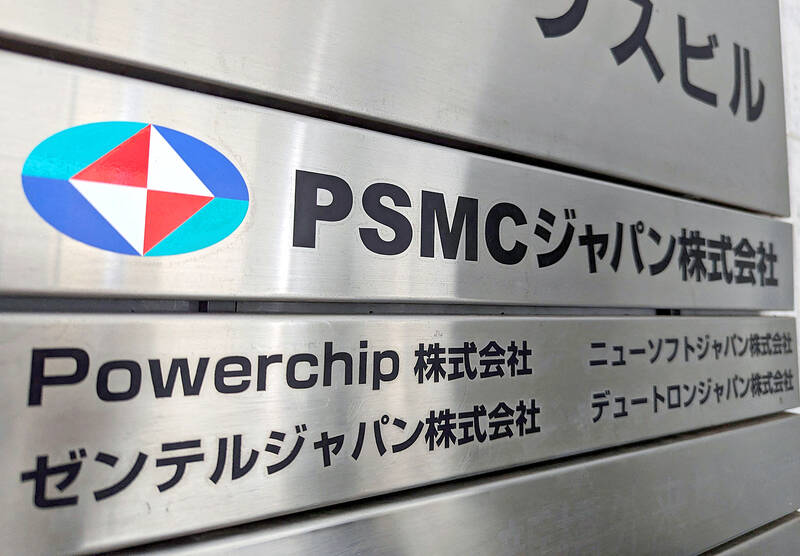Powerchip Semiconductor Manufacturing Corp (力積電) plans to build an ¥800 billion (US$5.3 billion) factory in northeast Japan with financing from investment group SBI Holdings Inc and the Japanese government, the latest boost to the nation’s bid to expand its chip manufacturing base.
The factory would require an initial investment of ¥420 billion, of which Powerchip and SBI would pay more than half, the firms said.
The rest would come from investors, bank loans and government subsidies, they said.

Photo: Reuters
The foundry, to be built in Miyagi Prefecture, is to produce mature 40-nanometer and 55-nanometer semiconductors, focusing on automotive chips and power controllers, and is to go online in 2027, the companies said.
Japan, home to Toyota Motor Corp and Honda Motor Co, is a heavy user of such chips, produced by the likes of Tokyo-based Renesas Electronics Corp.
“We’ve made preparations to create an unbeatable foundry and build a semiconductor ecosystem,” SBI chief executive officer Yoshitaka Kitao told a news conference yesterday.
SBI is to pay about ¥100 billion of the initial investment and seek another ¥100 billion through a new fund it plans to set up, but will not build a foundry without subsidies, Kitao said.
Japanese Prime Minister Fumio Kishida’s administration is paying billions of dollars in subsidies to chipmakers moving production to Japan.
Spurred by the financial support, Powerchip’s bigger rival and industry leader Taiwan Semiconductor Manufacturing Co (台積電) is building a factory in southern Japan, with operations expected to begin next year.
US memorychip maker Micron Technology Inc, and domestic players Kioxia Holdings Corp and Rapidus Corp are also expanding production in the world’s third-largest economy, helped by government support.
“The automotive chips that Powerchip will focus on are precisely the kind of chips used in vehicles today and will help secure this production base,” Japanese Minister of Economy, Trade and Industry Yasutoshi Nishimura said at a regular news conference ahead of the investment announcement.
“We want to secure the supplementary budget necessary to strengthen our semiconductor supply chain,” Nishimura added.
Japan, which wants to claw back its former leadership in chips, is benefiting from a shift in global supply chains as manufacturers seek to lower reliance on Taiwan and hedge against rising US-China tensions.
Washington is also offering incentives to chipmakers building capacity in the US, but progress has been slow.
Japan is “the best place” for semiconductor investment, Powerchip chairman Frank Huang (黃崇仁) said.
With so much capacity coming online in Japan, it remains unclear how companies would be able to secure enough engineering talent, given a weak yen.
Powerchip’s move comes as the chip sector fights to regain its footing from a sharp drop in demand following the COVID-19 pandemic.
The Taiwanese contract chipmaker had a tough first half, with little profit due to weak sales.
It reportedly told investors in July that it would be conservative with capacity expansion going forward.

RUN IT BACK: A succesful first project working with hyperscalers to design chips encouraged MediaTek to start a second project, aiming to hit stride in 2028 MediaTek Inc (聯發科), the world’s biggest smartphone chip supplier, yesterday said it is engaging a second hyperscaler to help design artificial intelligence (AI) accelerators used in data centers following a similar project expected to generate revenue streams soon. The first AI accelerator project is to bring in US$1 billion revenue next year and several billion US dollars more in 2027, MediaTek chief executive officer Rick Tsai (蔡力行) told a virtual investor conference yesterday. The second AI accelerator project is expected to contribute to revenue beginning in 2028, Tsai said. MediaTek yesterday raised its revenue forecast for the global AI accelerator used

TEMPORARY TRUCE: China has made concessions to ease rare earth trade controls, among others, while Washington holds fire on a 100% tariff on all Chinese goods China is effectively suspending implementation of additional export controls on rare earth metals and terminating investigations targeting US companies in the semiconductor supply chain, the White House announced. The White House on Saturday issued a fact sheet outlining some details of the trade pact agreed to earlier in the week by US President Donald Trump and Chinese President Xi Jinping (習近平) that aimed to ease tensions between the world’s two largest economies. Under the deal, China is to issue general licenses valid for exports of rare earths, gallium, germanium, antimony and graphite “for the benefit of US end users and their suppliers

Dutch chipmaker Nexperia BV’s China unit yesterday said that it had established sufficient inventories of finished goods and works-in-progress, and that its supply chain remained secure and stable after its parent halted wafer supplies. The Dutch company suspended supplies of wafers to its Chinese assembly plant a week ago, calling it “a direct consequence of the local management’s recent failure to comply with the agreed contractual payment terms,” Reuters reported on Friday last week. Its China unit called Nexperia’s suspension “unilateral” and “extremely irresponsible,” adding that the Dutch parent’s claim about contractual payment was “misleading and highly deceptive,” according to a statement

The Chinese government has issued guidance requiring new data center projects that have received any state funds to only use domestically made artificial intelligence (AI) chips, two sources familiar with the matter told Reuters. In recent weeks, Chinese regulatory authorities have ordered such data centers that are less than 30 percent complete to remove all installed foreign chips, or cancel plans to purchase them, while projects in a more advanced stage would be decided on a case-by-case basis, the sources said. The move could represent one of China’s most aggressive steps yet to eliminate foreign technology from its critical infrastructure amid a